Mohr–Mascheroni theorem
In mathematics, the Mohr–Mascheroni theorem states that any geometric construction that can be performed by a compass and straightedge can be performed by a compass alone.
It must be understood that by "any geometric construction", we are referring to figures that contain no straight lines, as it is clearly impossible to draw a straight line without a straightedge. It is understood that a line is determined provided that two distinct points on that line are given or constructed, even though no visual representation of the line will be present. The theorem can be stated more precisely as:[1]
- Any Euclidean construction, insofar as the given and required elements are points, may be completed with the compass alone if it can be completed with both the compass and the straightedge together.
Though the use of a straightedge can make a construction significantly easier, the theorem shows that any set of points that fully defines a constructed figure can be determined with compass alone, and the only reason to use a straightedge is for the aesthetics of seeing straight lines, which for the purposes of construction is functionally unnecessary.
History
The result was originally published by Georg Mohr in 1672,[2] but his proof languished in obscurity until 1928.[3][4][5] The theorem was independently discovered by Lorenzo Mascheroni in 1797 and it was known as Mascheroni's Theorem until Mohr's work was rediscovered.[6]
Motivated by Mascheroni's result, in 1822 Jean Victor Poncelet conjectured a variation on the same theme. He proposed that any construction possible by straightedge and compass could be done with straightedge alone. The one stipulation though is that a single circle with its center identified must be provided. The Poncelet-Steiner theorem was proved by Jakob Steiner eleven years later. This was a generalization of the proofs given by Ferrari and Cardano and several others in the 16th century where they demonstrated that all the constructions appearing in Euclid's Elements were possible with a straightedge and a "rusty" (fixed-width) compass.[7]
Constructive proof approach
To prove the theorem, each of the basic constructions of compass and straightedge need to be proven to be possible by using a compass alone, as these are the foundations of, or elementary steps for, all other constructions. These are:
- Creating the line through two existing points
- Creating the circle through one point with centre another point
- Creating the point which is the intersection of two existing, non-parallel lines
- Creating the one or two points in the intersection of a line and a circle (if they intersect)
- Creating the one or two points in the intersection of two circles (if they intersect).
#1 - A line through two points
It is understood that a straight line cannot be drawn without a straightedge. A line is considered to be given by any two points, as any two points define a line uniquely, and a unique line can be defined by any two points on it. In keeping with the intent of the theorem which we aim to prove, the actual line need not be drawn but for aesthetic reasons. This fact will be shown when all other constructions involving the line are proven.
#2 - A circle through one point with defined center
This can be done with compass alone quite naturally; it is the very purpose for which compasses are meant. There is nothing to prove. Any doubts about this construction would equally apply to traditional constructions that do involve a straightedge.
#5 - Intersection of two circles
This construction can be done directly with a compass provided the centers and radii of the two circles are known. Due to the compass-only construction of the center of a circle (given below), it can always be assumed that any circle is described by its center and radius. Indeed, some authors include this in their descriptions of the basic constructions.[8][9][10]
#3, #4 - The other constructions
Thus, to prove the theorem, there only compass-only constructions for #3 and #4 need to be given.
Alternative proofs
Several proofs of the result are known. Mascheroni's proof of 1797 was generally based on the idea of using reflection in a line as the major tool. Mohr's solution was different.[3] In 1890, August Adler published a proof using the inversion transformation.[11]
An algebraic approach uses the isomorphism between the Euclidean plane and the real coordinate space . This approach can be used to provide a stronger version of the theorem.[12] It also shows the dependence of the theorem on Archimedes' axiom (which cannot be formulated in a first-order language).
Constructive proof
The following notation will be used throughout this article. A circle whose center is located at point U and that passes through point V will be denoted by U(V). A circle with center U and radius specified by a number, r, or a line segment AB will be denoted by U(r) or U(AB), respectively.[13]
In general constructions there are often several variations that will produce the same result. The choices made in such a variant can be made without loss of generality. However, when a construction is being used to prove that something can be done, it is not necessary to describe all these various choices and, for the sake of clarity of exposition, only one variant will be given below. However, many constructions come in different forms depending on whether or not they use circle inversion and these alternatives will be given if possible.
Some preliminary constructions
To prove the above constructions #3 and #4, which are included below, a few necessary intermediary constructions are also explained below since they are used and referenced frequently. These are also compass-only constructions. All constructions below rely on #1,#2,#5, and any other construction that is listed prior to it.
Compass equivalence theorem (circle translation)
The ability to translate, or copy, a circle to a new center is vital in these proofs and fundamental to establishing the veracity of the theorem. The creation of a new circle with the same radius as the first, but centered at a different point, is the key feature distinguishing the collapsing compass from the modern, rigid compass. The equivalence of a collapsing compass and a rigid compass was proved by Euclid (Book I Proposition 2 of The Elements) using straightedge and collapsing compass when he, essentially, constructs a copy of a circle with a different center. This equivalence can also be established with compass alone, a proof of which can be found in the main article.
Reflecting a point across a line
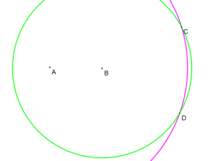
- Given a line segment AB and a point C not on the line determined by that segment, construct the image of C upon reflection across this line.
- Construct two circles: one centered at A and one centered at B, both passing through C.
- D, the other point of intersection of the two circles, is the reflection of C across the line AB. If C = D (that is, there is a unique point of intersection of the two circles), then C lies on the line AB and equals its own reflection (contrary to the assumption).
Extending the length of a line segment
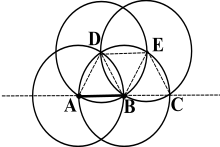
- Given a line segment AB find a point C on the line AB such that B is the midpoint of line segment AC.[14]
- Construct point D as the intersection of circles A(B) and B(A). (∆ABD is an equilateral triangle.)
- Construct point E ≠ A as the intersection of circles D(B) and B(D). (∆DBE is an equilateral triangle.)
- Finally, construct point C ≠ D as the intersection of circles B(E) and E(B). (∆EBC is an equilateral triangle, and the three angles at B show that A, B and C are collinear.)
This construction can be repeated as often as necessary to find a point Q so that the length of line segment AQ = n⋅ length of line segment AB for any positive integer n.
Inversion in a circle
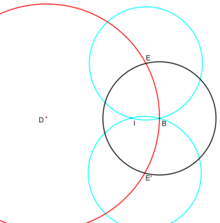
- Given a circle B(r), for some radius r (in black) and a point D (≠ B) construct the point I that is the inverse of D in the circle.[15] Naturally there is no inversion for a point .
- Draw a circle D(B) (in red).
- Assume that the red circle intersects the black circle at E and E'
- if the circles do not intersect in two points see below for an alternative construction.
- if the circles intersect in only one point, , it is possible to invert simply by doubling the length of (quadrupling the length of ).
- Reflect the circle center across the line :
- Construct two new circles E(B) and E' (B) (in light blue).
- The light blue circles intersect at B and at another point I ≠ B.
- Point I is the desired inverse of D in the black circle.
Point I is such that the radius r of B(r) is to IB as DB is to the radius; or IB / r = r / DB.
In the event that the above construction fails (that is, the red circle and the black circle do not intersect in two points),[16] find a point Q on the line BD so that the length of line segment BQ is a positive integral multiple, say n, of the length of BD and is greater than r / 2 (this is possible by Archimede's axiom). Find Q' the inverse of Q in circle B(r) as above (the red and black circles must now intersect in two points). The point I is now obtained by extending BQ' so that BI = n ⋅ BQ' .
Determining the center of a circle through three points
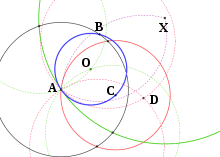
- Given three non-collinear points A, B and C, find the center O of the circle they determine.[17]
- Construct point D, the inverse of C in the circle A(B).
- Reflect A in the line BD to the point X.
- O is the inverse of X in the circle A(B).
Intersection of two non-parallel lines (construction #3)
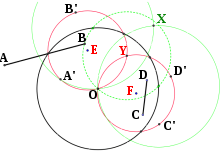
- Given non-parallel lines AB and CD, find their point of intersection, X.[17]
- Select circle O(r) of arbitrary radius whose center O does not lie on either line.
- Invert points A and B in circle O(r) to points A' and B' respectively.
- The line AB is inverted to the circle passing through O, A' and B'. Find the center E of this circle.
- Invert points C and D in circle O(r) to points C' and D' respectively.
- The line CD is inverted to the circle passing through O, C' and D'. Find the center F of this circle.
- Let Y ≠ O be the intersection of circles E(O) and F(O).
- X is the inverse of Y in the circle O(r).
Intersection of a line and a circle (construction #4)
The compass-only construction of the intersection points of a line and a circle breaks into two cases depending upon whether the center of the circle is or is not collinear with the line.
Circle center is not collinear with the line
Assume that center of the circle does not lie on the line.
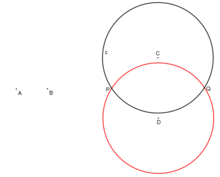
- Given a circle C(r) (in black) and a line AB. We wish to construct the points of intersection, P and Q, between them (if they exist).[9][18]
- Construct the point D, which is the reflection of point C across line AB. (See above.)
- Under the assumption of this case, C ≠ D.
- Construct a circle D(r) (in red). (See above, compass equivalence.)
- The intersections of circle C(r) and the new red circle are points P and Q.
- If the two circles are tangential then .
- Points P and Q are the intersection points of circle C(r) and the line AB.
- If then the line is tangential to the circle .
An alternate construction, using circle inversion can also be given.[17]
- Given a circle C(r) and a line AB. We wish to construct the points of intersection, P and Q, between them (if they exist).
- Invert points A and B in circle C(r) to points A' and B' respectively.
- The line AB is inverted to the circle passing through C, A' and B'. Find the center E of this circle.
- P and Q are the intersection points of circles C(r) and E(C).[19]
Circle center is collinear with the line
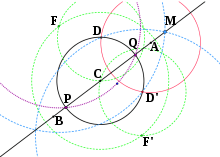
- Given the circle C(D) whose center C lies on the line AB, find the points P and Q, the intersection points of the circle and the line.[20]
- Construct point D' ≠ D as the other intersection of circles A(D) and C(D).
- Construct point F as the intersection of circles C(DD' ) and D(C). (F is the fourth vertex of parallelogram CD'DF.)
- Construct point F' as the intersection of circles C(DD' ) and D' (C). (F' is the fourth vertex of parallelogram CDD'F'.)
- Construct point M as an intersection of circles F(D' ) and F' (D). (M lies on AB.)
- Points P and Q are the intersections of circles F(CM) and C(D).
Thus it has been shown that all of the basic construction one can perform with a straightedge and compass can be done with a compass alone, provided that it is understood that a line cannot be literally drawn but merely defined by two points.
See also
Notes
- Eves 1963, p. 201
- Georg Mohr, Euclides Danicus (Amsterdam: Jacob van Velsen, 1672).
- Eves 1963, p. 199
- Hjelmslev, J. (1928) "Om et af den danske matematiker Georg Mohr udgivet skrift Euclides Danicus, udkommet i Amsterdam i 1672" [Of a memoir Euclides Danicus published by the Danish mathematician Georg Mohr in 1672 in Amsterdam], Matematisk Tidsskrift B , pages 1–7.
- Schogt, J. H. (1938) "Om Georg Mohr's Euclides Danicus," Matematisk Tidsskrift A , pages 34–36.
- Lorenzo Mascheroni, La Geometria del Compasso (Pavia: Pietro Galeazzi, 1797). 1901 edition.
- Retz, Merlyn; Keihn, Meta Darlene (1989), "Compass and Straightedge Constructions", Historical Topics for the Mathematics Classroom, National Council of Teachers of Mathematics (NCTM), p. 195, ISBN 9780873532815
- Eves 1963, p. 202
- Hungerbühler 1994, p. 784
- Pedoe 1988, p.122
- Eves 1963, p. 198
- Arnon Avron, "On strict strong constructibility with a compass alone", Journal of Geometry (1990) 38: 12.
- Eves 1963, p. 184
- Pedoe 1988, p. 78
- Pedoe 1988, p. 77
- Pedoe 1988, p. 78
- Pedoe 1988, p. 123
- Eves 1963, p. 199
- Pedoe carries out one more inversion at this point, but the points P and Q are on the circle of inversion and so are invariant under this last unneeded inversion.
- Eves 1963, p. 200
References
- Eves, Howard (1963), A Survey of Geometry (Volume One), Allyn and Bacon
- Hungerbühler, Norbert (1994), "A Short Elementary Proof of the Mohr–Mascheroni Theorem", The American Mathematical Monthly, 101 (8): 784–787, doi:10.1080/00029890.1994.11997027
- Pedoe, Dan (1988) [1970], Geometry / A Comprehensive Course, Dover, ISBN 978-0-486-65812-4
Further reading
- Pedoe, Dan (1995) [1957], "1 Section 11: Compass geometry", Circles / A Mathematical View, Mathematical Association of America, pp. 23–25, ISBN 978-0-88385-518-8
- Posamentier, Alfred S.; Geretschläger, Robert (2016), "8. Mascheroni constructions using only the compass", The Circle, Prometheus Books, pp. 197–216, ISBN 978-1-63388-167-9